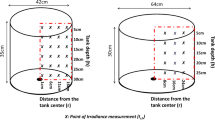Abstract
Tank cultivation of marine macroalgaeinvolves air-agitation of the algal biomassand intermittent light conditions,i.e.periodic, short light exposure of thethalli in the range of 10 s at the watersurface followed by plunging to low lightor darkness at the tank bottom andrecirculation back to the surface in therange of 1–2 min. Open questions relate toeffects of surface irradiance on growthrate and yield in such tumble cultures andthe possibility of chronic photoinhibitionin full sunlight. A specially constructedshallow-depth tank combined with a darktank allowed fast circulation times ofapproximately 5 s, at a density of 4.2 kgfresh weight (FW) m-2s-1. Growthrate and yield of the red alga Palmaria palmata increased over a widerange of irradiances, with no signs ofchronic photoinhibition, up to agrowth-saturating irradiance ofapproximately 1600 μmol m-2s-1 in yellowish light supplied by asodium high pressure lamp at 16 h light perday. Maximum growth rate ranged at 12% FWd-1, and maximum yield at 609 gFW m-2 d-1. This shows that highgrowth rates of individual thalli may bereached in a dense tumble culture, if highsurface irradiances and short circulationtimes are supplied. Another aspect ofintermittent light relates to possiblechanges of basic growth kinetics, ascompared to continuous light. For thispurpose on-line measurements of growth ratewere performed with a daily light reductionby 50% in light-dark cycles of 1, 2 or 3min duration during the daily light period.Growth rates at 10 °C and 50 μmolphoton m-2 s-1 dropped in allthree intermittent light regimes duringboth the main light and dark periods andreached with all three periodicitiesapproximately 50% of the control , with noapparent changes in basic growth kinetics,as compared to continuous light.
Similar content being viewed by others
References
Bidwell RGS, McLachlan J, Lloyd NDH (1985) Tank cultivation of Irish moss, Chondrus crispusStackh. Bot. mar. 28: 87–97.
Evans F, Langdon CJ (2000) Co-culture of dulse Palmaria mollisand red abalone Haliotis rufescensunder limited flow conditions. Aquaculture 185: 137–158.
Franklin LA, Forster RM (1997) The changing irradiance en-vironment: consequences for marine macrophytic physiology, productivity and ecology. Eur. J. Phycol. 32: 207–232.
Galland-Irmouli AV, Fleurence J, Lamghari R, Luçon M, Rouxel, X, Barbaroux O, Bronowicki JP, Villaume C, Guéant JL (1999) Nu-tritional value of proteins from edible seaweed Palmaria palmata(dulse). J. Nutrit. Biochem. 10: 353–359.
Guiry, MD, Blunden, G (1992) Seaweed Resources in Europe. Uses and Potential. Wiley, Chichester, UK.
Hanelt D, Huppert K, Nultsch W (1992) Photoinhibition of photo-synthesis and its recovery in red algae. Bot. Acta 105: 278–284.
Harris GP (1980) Temporal and spatial scales in phytoplankton eco-logy. Mechanisms, methods, models and management. Can. J. Fish. aquat. Sci. 37: 877–900.
Henley WJ, Ramus J (1989) Photoacclimation and growth rate re-sponses of Ulva rotundata(Chlorophyta) to intraday variations in growth irradiance. J. Phycol. 25: 398–401.
Lobban, CS, Harrison, PJ (1994) Seaweed Ecology and Physiology. Cambridge University Press, 366 pp.
Lüning K (1990) Seaweeds. Their Environment, Biogeography and Ecophysiology. Wiley, New York: 527 pp.
Lüning K (1992) Day and night kinetics of growth rate in green, brown, and red seaweeds. J. Phycol. 28: 794–803.
Lüning K (1994) Circadian growth rhythm in juvenile sporophytes of Laminariales (Phaeophyta). J. Phycol. 30: 193–199.
Lüning K, Pang S (2003) Mass cultivation of seaweeds: current aspects and approaches. J. appl. Phycol. 15: 115–119.
Morgan KC, Wright JLC, Simpson FJ (1979) Review of chemical constituents of the red alga Palmaria palmata(dulse). Econ. Bot. 34: 27–50.
Morgan KC, Shacklock PF, Simpson FJ (1980) Some aspects of the culture of Palmaria palmatain greenhouse tanks. Bot. mar. 23: 765–770.
Morgan KC, Simpson FJ (1981a) The cultivation of Palmaria pal-mata. Effect of light intensity and nitrate supply on growth and chemical composition. Bot. mar. 24: 272–277.
Morgan KC, Simpson FJ (1981b). Cultivation of Palmaria (Rhody-menia) palmata: effect of high concentrations of nitrate and ammonium on growth and nitrogen uptake. Aquat. Bot. 11: 167–171.
Pang S, Gomez I, Lüning K (2001) The red macroalga Delesseria sanguineaas a UBV-sensitive model organism: selective growth reduction by UVB in outdoor experiments and rapid recording of growth rate during and after UV pulses. Eur. J. Phycol. 36: 207–216.
Rosen G, Langdon CJ, Evans F (2000) The nutritional value of Palmaria molliscultured under different light intensities and wa-ter exchange rates for juvenile red abalone Haliotis rufescens. Aquaculture 185: 121–136.
Russell AW, Critchley C, Robinson SA, Franklin LA, Seaton GGR, Chow WS, Anderson JM, Osmond CB (1995) Photosystem II regulation and dynamics of the chloroplast D1 protein in Ara-bidopsisleaves during photosynthesis and photoinhibition. Plant Physiol. 107: 943–952.
Sagert S, Schubert H (1995) Acclimation of the photosynthetic ap-paratus of Palmaria palmata(Rhodophyta) to light qualities that preferentially excite photosystem I or photosystem II. J. Phycol. 31: 547–554.
Sagert S, Schubert H (2000) Acclimation of Palmaria palmata(Rhodophyta) to light intensity: comparison between artificial and natural light fields. J. Phycol. 36: 1119–1128.
Starr R, Zeikus, JA (1987) UTEX-The culture collection of algae at the University of Texas at Austin. J. Phycol. 23 (Suppl.): 1–47.
Vadas SRL, Beal B, Dowling T, Fegley JC (2000) Experimental field tests of natural algal diets on gonad index and quality in the green sea urchin, Strongylocentrotus droebachiensis: a case for rapid summer production in post-spawned animals. Aquaculture 182: 115–135.
Rights and permissions
About this article
Cite this article
Pang, S., Lüning, K. Tank cultivation of the red alga Palmaria palmata: Effects of intermittent light on growth rate, yield and growth kinetics. Journal of Applied Phycology 16, 93–99 (2004). https://doi.org/10.1023/B:JAPH.0000044779.30182.d8
Issue Date:
DOI: https://doi.org/10.1023/B:JAPH.0000044779.30182.d8




